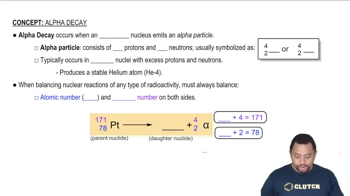Here are the essential concepts you must grasp in order to answer the question correctly.
Nuclear Decay
Nuclear decay is the process by which an unstable atomic nucleus loses energy by emitting radiation. This can occur through various modes, including alpha decay, beta decay, and gamma decay. Each mode involves the transformation of the nucleus, resulting in the emission of particles or electromagnetic radiation, leading to the formation of a different nuclide.
Recommended video:
Nuclear Equations
Nuclear equations represent the transformation of one nuclide into another during radioactive decay. They are written to show the initial nuclide, the emitted particles, and the resulting nuclide. For example, in alpha decay, the equation includes the original nuclide, an alpha particle (helium nucleus), and the new nuclide formed after the decay.
Recommended video:
Types of Radioactive Decay
Different unstable nuclides undergo specific types of radioactive decay based on their nuclear structure. Alpha decay involves the emission of helium nuclei, beta decay involves the conversion of a neutron into a proton (or vice versa), and positron emission or electron capture can also occur. Understanding the characteristics of each nuclide helps predict the most likely decay mode.
Recommended video:
Rate of Radioactive Decay
 Verified step by step guidance
Verified step by step guidance


